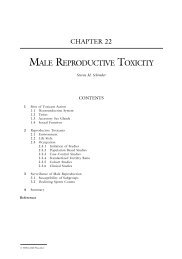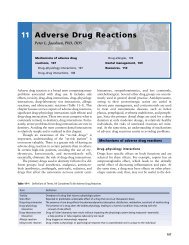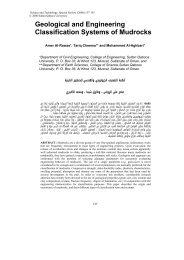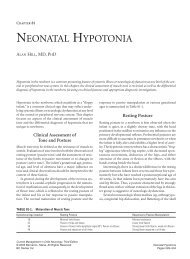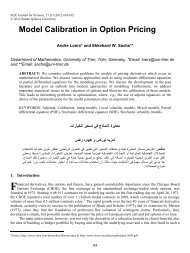A Comprehensive Review of Boundary Integral Formulations of ...
A Comprehensive Review of Boundary Integral Formulations of ...
A Comprehensive Review of Boundary Integral Formulations of ...
You also want an ePaper? Increase the reach of your titles
YUMPU automatically turns print PDFs into web optimized ePapers that Google loves.
Science and Technology, Special <strong>Review</strong> (2000) 281-310© 2000 Sultan Qaboos UniversityA <strong>Comprehensive</strong> <strong>Review</strong> <strong>of</strong> <strong>Boundary</strong><strong>Integral</strong> <strong>Formulations</strong> <strong>of</strong> AcousticScattering ProblemsS.I.ZamanDepartment <strong>of</strong> Mathematics & Statistics, College <strong>of</strong> Science, Sultan QaboosUniversity, P. O. Box 33, Al Khod 123, Muscat, Sultanate <strong>of</strong> Oman.مراجعة شاملة للم عادلات التكاملية المحددة لمسائل الارتدادات الصوتيةسيف الاسلام زمانخلاصة: تمت مراجعة شاملة لكل تطورات المعادلات التكاملية المحددة لمسائل الارتدادات الصوتية وبشكل عام ،تشكلتالمسألة بطريقتين: الأولى بمعادلة جرين والثانية باستخدام لير في التكوين النظري إما باستعداد لير البسيط أو الثنائي. و هذهالمراجعة تظهر و تفسر المساهمات الأساسية في هذا الموضوع في الأربعة عقود الماضية إن الحاجة لتكوين معادلاتقوية و متطورة لمسألة الارتدادات الخارجية نيومان أو ديرشليت) ظهرت نسبه لأن الطريقة التقليدية لتكوين المعادلاتتعطي حلا وحيدا في أرقام الأمواج الصوتية و التي تعود للقيم الأيجينية (الترددات الأيجينية لمسألة الارتدادات الداخليةالمناظرة لها كما و أن الارتباط يكون اكثر كفاءة كلما كبرت أرقام الأمواج بمعنى أخر كلما ازداد تردد الصوت إنتكوين معادلات التكامل و التي تمت مناقشتها هنا تعطي معادلات التكامل ل فردهولمز من النوع الثاني و التي تعتبر أكثرملاءمة للعمليات الحسابية من النوع الأول من هذه التكاملات و على الرغم من ذلك فان المعادلات التكاملية و التي تتعلقبالنواة المنفردة بقوة و التي تنتج شروطا صعبة في التمثيل للمصفوفة النهائية تم تناول الموضوع بطريقة مبررةهناك قائمة مهمة تفيد الباحثين و تشمل المراجع المهمة في الموضوع....(..ABSTRACT: This is a review presenting an overview <strong>of</strong> the developments in boundary integralformulations <strong>of</strong> the acoustic scattering problems. Generally, the problem is formulated in one <strong>of</strong>two ways viz. Green’s representation formula, and the Layer-theoretic formulation utilizing eithera simple-layer or a double-layer potential. The review presents and expounds the majorcontributions in this area over the last four decades. The need for a robust and improvedformulation <strong>of</strong> the exterior scattering problem (Neumann or Dirichlet) arose due to the fact thatthe classical formulation failed to yield a unique solution at (acoustic) wave-numbers whichcorrespond to eigenvalues (eigenfrequencies) <strong>of</strong> the corresponding interior scattering problem.Moreover, this correlation becomes more pronounced as the wave-numbers become larger i.e. asthe (acoustic) frequency increases. The robust integral formulations which are discussed hereyield Fredholms integral equations <strong>of</strong> the second kind which are more amenable to computationthan the first kind. However, the integral equation involves a hypersingular kernel which createsill-conditioning in the final matrix representation. This is circumvented by a regularisationtechnique.An extensive useful list <strong>of</strong> references is also presented here for researchers in this area.).281
S. I. ZAMANCONTENTS1. Introduction 2821.1 <strong>Boundary</strong> Condition 2852. Background Theory 2862.1 Helmholtz Surface Potentials 2862.2 Surface 2872.3 Properties <strong>of</strong> Helmholtz Potentials and Their Derivatives 2882.4 Helmholtz Formulae 2912.5 Differentiated Helmholtz Formula 2922.6 Layer-Theoretic Formula 2932.7 Connection Between the Interior and Exterior Problems 2953. Improved <strong>Integral</strong> Equation <strong>Formulations</strong> 2973.1 Brundrit 2973.2 Panich 2993.3 Copley 2993.4 Schenck 3003.5 Kussmaul 3013.6 Burton and Miller 3013.7 Ursell and Jones 3023.8 Piaszczyk and Klosner 3043.9 Zaman 3054. Conclusion 3065. Acknowledgment 3076. References 3071. IntroductionThe main purpose <strong>of</strong> this review is to give the general mathematical public an overview <strong>of</strong>the developments that occurred in the field <strong>of</strong> <strong>Boundary</strong> integral methods for acoustic scatteringproblems. Here, we are mainly concerned with the acoustic wave. The study <strong>of</strong> wave propagation in solidsand fluids is very important in many branches <strong>of</strong> physics and engineering. We concentrate mainly on thearea <strong>of</strong> time-harmonic acoustics. Acoustic problems like assessing and reducing the noise produced byaircrafts, vehicles, household appliances and machines in general have been <strong>of</strong> major concern and interest toindustry.Scattering problems (or radiation problems) in mathematical physics are concerned with finding thesolution <strong>of</strong> the Helmholtz equation,2 2∇ φ + k φ = 0(1)in an exterior domain. In the process <strong>of</strong> finding this solution, the integral equation method is veryconvenient. The Helmholtz equation (or the reduced wave equation) arises when we seek steady-statesolutions <strong>of</strong> the scalar wave equation for monochromatic (single frequency) sources. To give a general idea,consider a typical scattering problem: an incident wave with harmonic time-dependence is intercepted by abounded scatterer. Consequently, reflected and diffracted waves are produced which travel outwards fromthe scattering region, the propagation <strong>of</strong> the waves being described by the wave-equation,22( 1 ∂ Φ∇ Φ p , t)= ( P , t)(2)2c ∂ t2282
A COMPREHENSIVE REVIEW OF BOUNDARY INTEGRALwhere c is the speed <strong>of</strong> propagation and Φ is as defined in (3) below. It may also be regarded as the excesspressure at p in the exterior domain and at time t. Let us suppose that the wave-length <strong>of</strong> the sourceradiation is λ which corresponds to a frequency c/λ Hz, and assume that steady state has been reached sothat all waves present have harmonic time-dependence <strong>of</strong> this frequency. We can then write,−iωtΦ( p ; t)= φ(p ) e ; p = ( x ∈ R1, x2, x3)3(3)where φ is a complex function in the spatial co-ordinates and ω = kc. The constant k is the wave-number,defined as k = 2π/λ is a dimensionless quantity. By substituting (3) in equation (2) we see that φ is asolution <strong>of</strong> the Helmholtz equation given in (1).The problem as described above is generally speaking a diffraction problem. Such problems occurwidely in acoustics, electromagnetic theory, hydrodynamics etc. It is very important to know how theincident wave field is modified by the scatterer. Another type <strong>of</strong> scattering problem arises when the sourcesare actually on the scattering surface. In such situations one needs to know how the surface modifies theradiation characteristics <strong>of</strong> the source. As far as the mathematics is concerned, these two classes <strong>of</strong>problems are almost similar. For diffraction problems it is convenient to regard the total wave-function φ t atany point as being made up <strong>of</strong> two parts : a known incident wave φ inc , and a scattered wave φ sc which is tobe determined (the time factor e -iωt is omitted), so we have φ = φ + φ . The incident wave is simplythe wave-function that would exist in the absence <strong>of</strong> the scattering surfaces, and the scattered part is a wavediverging from the scattering region. A radiation condition is necessary for the scattered wave in order toensure that it represents a diverging wave. At the boundary <strong>of</strong> the scatterer, conditions are imposed on thetotal wave φ t , or its normal derivative or possibly a linear combination <strong>of</strong> the two, and the mathematicalproblem is to find an exterior wave-function which satisfies these boundary conditions and is such that thescattered wave obeys the radiation conditions. In reality the shape <strong>of</strong> the scatterer is usually arbitrarilyshaped . This demands a numerical method <strong>of</strong> solution especially if the solution is needed in the midfrequencyrange. And as such, it is convenient to reformulate the problem as an integral equation.<strong>Integral</strong> equations have been used extensively in formulating diffraction problems for analyticalsolution. The integral equations cannot usually be solved exactly in closed form, although the formulationvery <strong>of</strong>ten provides a very useful basis for asymptotic analysis. During this century much effort has beenconcentrated on developing new alternatives, such as numerical techniques, to deal with the mathematicalmodelling <strong>of</strong> the problems. Time-harmonic acoustic scattering problems are among the engineeringproblems for which the boundary element methods (BEM) have already been shown to yield powerfulnumerical techniques. As we will see later, the fundamental feature <strong>of</strong> the integral equation method is one<strong>of</strong> shifting the problem <strong>of</strong> solving a domain equation to a boundary equation which is usually an integralequation <strong>of</strong> the second kind. By applying BEM numerical techniques the solution is achieved, at least as anapproximation. The advantages <strong>of</strong> the BEM technique are that: only the boundary <strong>of</strong> the region (i.e. thesurface scatterer) needs discretisation; the explicit calculations <strong>of</strong> results at domain points i.e. in the region;the possibility <strong>of</strong> using continuous and discontinuous elements in the mesh; and the capability <strong>of</strong> modellinginfinite domains by discretisation <strong>of</strong> the internal boundary (surface <strong>of</strong> the scatterer only). During the latterhalf <strong>of</strong> the seventies, the appearance <strong>of</strong> texts like Jaswon and Symm (1977) and Brebbia (1978), on integralequations and their numerical solutions by discretisation, proliferated the popularity <strong>of</strong> integral equationmethods among the engineering community. Later on, Brebbia et al (1984) broadened the range <strong>of</strong>applications <strong>of</strong> BEM. The basic ideas <strong>of</strong> the BEM are not new to acoustic and structural engineers. Since1960s several integral equation methods have been used. In acoustics, these include, Shaw and Friedman(1962), Banaugh and Goldsmith (1963), Chen and Schweikert (1963), Copley (1967). The BEM was firstapplied to general transient elastodynamics in 1968 by Cruse and Rizzo (1968). Since then some moretincsc283
S. I. ZAMANdynamic applications emerged such as Niwa et al (1976), Domínguez (1978), Manolis and Bescos (1981),and Cole et al (1978).BEM is best suited when dealing with unbounded regions. In domain-based numerical methods, suchas finite element method (FEM) there are well known disadvantages. The use <strong>of</strong> integral equation methodspresents many advantages, notably in that the meshing region is reduced by one dimension i.e. from theinfinite domain exterior to the body (scatterer) to its finite surface, and the Sommerfeld radiation conditionat infinity is automatically satisfied. However, there is a well-known drawback in that the standard integralequation formulations obtained from the Green’s representation formula, for time-harmonic acoustics, failto have a unique solution at frequencies corresponding to the eigenfrequencies <strong>of</strong> the adjoint associatedinterior problem. This is not a physical drawback and nor indeed does it appear when the problem isrepresented by partial differential equations, but comes up entirely as a result <strong>of</strong> a deficiency <strong>of</strong> the integralequation representation. We shall look into this in detail later. Over the last thirty years several techniqueshave been proposed to circumvent these fictitious eigenfrequencies. Indeed the existence and uniqueness <strong>of</strong>solutions <strong>of</strong> the radiation problem, i.e. the exterior Neumann boundary value problem for the Helmholtzwave equation, has been proved for all values <strong>of</strong> wave-numbers by Leis (1958). However, this matter isstill one <strong>of</strong> the main areas <strong>of</strong> research in the BEM. For acoustic problems, some <strong>of</strong> the most promisingtechniques have been proposed by Panich (1965), Schenck (1968), Kussmaul (1969), Burton and Miller(1971), Ursell (1973) and Jones (1984,85). More recently, Zaman (1994) proposed a technique using amodified hybrid layer potentials, based on the theory <strong>of</strong> potentials.Let us first consider the equations governing acoustics. The propagation <strong>of</strong> small amplitude acousticwaves through a fluid medium is as described by the linear wave equation given in (2), where Φ is avelocity potential and c is the velocity <strong>of</strong> sound in the medium. When the motion is considered to be timeharmonic,the function Φ may be represented as in (3), where φ is a reduced velocity potential and ω is theangular frequency, and thus equation (2) reduces to the Helmholtz equation (1), where k is the wave-numberas defined before.Let ρ o, p o be the density and pressure, respectively, <strong>of</strong> the fluid at rest. At time t, the excess pressureand the particle velocity, denoted by p and u , are related by Newton’s equation <strong>of</strong> motion,Usually we describe a sound field in terms <strong>of</strong> a velocity potential Φ byHence the excess pressure, after substituting (5) in (4), is∂uρo= − ∇P(4)∂tu =∇Φ (5)∂ΦP = − ρ o (6)∂tAnd consequently by using (3), the velocity potential φ is related to the acoustic pressure P byP = -iω ρ o φ (7)ρ o is assumed constant here. Helmholtz equation (1) is in fact the governing equation <strong>of</strong> a steady-statesound wave propagation problem. The acoustic scattering problem seeks the solution <strong>of</strong> this equation in theexterior region where the solution satisfies some boundary conditions.284
A COMPREHENSIVE REVIEW OF BOUNDARY INTEGRAL1.1 <strong>Boundary</strong> ConditionsThere are basically two types <strong>of</strong> scattering surfaces which yield two different types <strong>of</strong> boundaryconditions. One condition is for perfectly s<strong>of</strong>t scatterers and the other for perfectly hard scatterers. At thesurface <strong>of</strong> a s<strong>of</strong>t scatterer the excess pressure p is zero which in view <strong>of</strong> (7) givesφ ( p)= 0 for all p on the boundary (8)tAt a perfectly hard or rigid scattering surface the incoming wave is completely reflected i.e. no part <strong>of</strong> thewave enters the surface which means that the normal component u . n <strong>of</strong> the particle velocity vanishes at thesurface and hence, from (5),∂φ t∂n( p)= 0for all p on the boundary (9)The condition (8) is a form <strong>of</strong> homogeneous Dirichlet boundary condition and the condition (9) is a form <strong>of</strong>homogeneous Neumann condition. In order to determine the exterior solution uniquely, it is not sufficient tohave the boundary condition on the surface only. But from the physical point <strong>of</strong> view it is essential that thescattered wave be entirely outgoing. In order to ensure this, we have to impose a radiation condition:I. In three dimensions,II.In two dimensions,r → ∞Lim r [( ∂φ/ ∂r)− ikφ] = 0r → ∞sc2Lim r1 [( ∂ / ∂r)− ikφ] = 0scscscφ (10)where r is the length <strong>of</strong> the vector p measured from a fixed origin in the scattering region to a general fieldpoint. This condition was first expressed formally by Sommerfeld (1949), and later by Kupradze (1965),Atkinson (1949), Rellich (1943) and Wilcox (1956).Let us now collate all the above and consider the mathematical statement <strong>of</strong> the general scatteringproblem. We have seen how time-harmonic wave problems in acoustics and indeed in diffraction, can bereduced to finding solutions <strong>of</strong> Helmholtz equation, and we have also considered some <strong>of</strong> the moreappropriate boundary conditions, (8) and (9). In scattering problems, wave-functions are sought in exteriordomains, which satisfy not only boundary conditions at the surface <strong>of</strong> the scatterer but also the radiationcondition at infinity. The surface boundary conditions are usually <strong>of</strong> three main types:(i) φ = f for the Dirichlet problem,(ii)∂φ=∂nfforthe Neumann problem,(iii)∂φ=∂n + h φfforthe Robin problemn is the outward normal to the surface and f, h are given functions. In the diffraction case, where the totalwave is expressed as the sum <strong>of</strong> incident and scattered waves, we have seen that appropriate boundaryconditions are <strong>of</strong>ten homogeneous. So the diffraction problem reads:285
S. I. ZAMAN(i)Solve ∇ 2 φ t + k 2 φ t = 0 in the exterior region, where(ii) φ t = φ inc + φ sc ,(iii) with φ t = 0 or∂φ t∂φt= 0 or + hφt= 0∂n∂n(iv) with φ sc satisfying the radiation condition in (10)on the boundary.It is more convenient and appropriate to work in terms <strong>of</strong> the scattered wave rather than the total wave.Bearing in mind that φ = φ + φ , the diffraction problem reads:t22(i) Solve ∇ φ sc+ k φ = 0 in the exterior regionincscinc(ii) with φsc = −φ[ Dirichlet ]or∂φsc∂n∂φ= −∂nincsc[Neumann]∂φsc⎡∂φinc⎤or + hφsc= − ⎢ + hφinc⎥ [Robin] (11)∂n⎣∂n⎦on the boundary(iii) with φ sc satisfying the radiation condition in (10).In a radiation-only situation, the problem is similar. Here the solution behaves like a scattered wavesatisfying the radiation condition, hence the problem to can be specified in the form (11), with the incidentwave terms replaced by given functions describing the surface properties <strong>of</strong> the sources and the scatterer.Analytical solutions to typical scattering problems are seldom obtainable. Surface shapes andspecified normal velocities are quite general. Even asymptotic approximation methods (large or small k) areusually inappropriate because the solutions <strong>of</strong> interest are <strong>of</strong>ten those for which the wavelength <strong>of</strong> thesource radiation is comparable with the size <strong>of</strong> the scatterer. As such, numerical approach is the only logicaloption. Although for an elliptic equation (i.e. Helmholtz equation) it is natural to think in terms <strong>of</strong> eitherfinite difference method or finite element method (FEM), there are some basic difficulties, one <strong>of</strong> which isthat the region <strong>of</strong> interest is at infinity. On the other hand, the boundary element method (BEM) isappropriate for this problem.2. Background TheoryBefore considering different integral equation formulations for the interior as well as the exteriorHelmholtz problems (acoustic scattering problems for instance), it will be worthwhile looking into thedefinitions <strong>of</strong> simple-layer and double-layer Helmholtz potentials, and also investigating their properties.2.1 Helmholtz Surface Potentials−Consider a domain B bounded by a closed surface ∂B, and let σ be a density function defined on ∂B. Thesimple-layer and double-layer potentials are defined as follows:Simple-layer :kσ ( x)= g k ( x,y)σ ( y dy(12)∫ ∂ BL )286
A COMPREHENSIVE REVIEW OF BOUNDARY INTEGRALM∂gkσ ( x)= ( x,y)σ ( y dy(13)∫ ∂∂nDouble-layer :k )B ywhere L k and M k are the simple and double-layer potential operators, x and y are positions in threedimension. The integration is performed at y∈∂B, n y is the outward normal at y and x is any other point−either in the interior B , exterior B+ or on the boundary ∂B. g k (x, y) is the free-space Green’s function forHelmholtz equation, i.e.,( ∇22( x y )+ k ) gk ( x,y)= − 4πδ−where δ is the Dirac delta function and g k satisfies the radiation condition in (10). When the time factor e -iωtis included, g k represents the effect experienced at x <strong>of</strong> a point y (or vice-versa) radiating into free space ineither two or three dimensions, more precisely, it represents the potential at x generated by a unit pointsource at y (and vice-versa). In three dimension, this function is(14)g k (x, y) =−ikx−yex − y(15)The free space Green’s function is closely related to the corresponding functions for Laplace’s equation (k =0), in that they possess the same singularity for | x – y |=0. This may readily be seen by expanding thefunctions for small | x – y |< ε, where ε is very small. So we find that in three dimensions, as | x – y |→ 0,1g k ( x,y)= + o(1)= g0 ( x,y)+ o(1)(16)x − yIt is this weak singularity which is responsible for the continuity properties <strong>of</strong> the surface potentials,particularly the jump properties as the point x crosses the surface ∂B. Because the singularity is the same forHelmholtz potentials as for the more familiar potentials associated with Laplace’s equation, the propertiescan be obtained as in classical potential theory (Kellogg, 1929; Günter, 1967).2.2 SurfaceIt is clear from the definitions (12) and (13) <strong>of</strong> the potentials that whether or not the integrals existand indeed whether or not they define the operatorss L k and M k , depends on three interrelated factors:(I) the behaviour <strong>of</strong> the layer or the surface density function σ,∂g (II) the singularities <strong>of</strong> the kernel functions, viz. g k and k,∂n(III) the nature <strong>of</strong> the surface ∂B.The development <strong>of</strong> classical potential theory followed two paths. Russian workers (Günter, 1967)built up the theory based on the concept <strong>of</strong> the Lyapunov surface, whereas Kellogg (1929) in his classicwork introduced the idea <strong>of</strong> a regular surface. For these two types <strong>of</strong> surface slightly different conditions arerequired on σ in order to establish the existence <strong>of</strong> the potentials. In the present review we will not delveinto details <strong>of</strong> these two types <strong>of</strong> surfaces. However let us look into the definitions <strong>of</strong> these surfaces.287
S. I. ZAMANA Lyapunov surface S satisfies the following three conditions (Smirnov, 1964; Günter, 1967):(i) a tangent plane exists at every point <strong>of</strong> the surface S.(ii) ∀x ∈ S, ∃ε > 0 such that S ∩{y | |x – y| < ε} intersects lines parallel to the normal at x in at most onepoint. It is self-evident that if this property holds for any given ε it also holds for any smaller ε.−1(iii) if θ = cos ( nˆ0.nˆ1), where nˆ0, nˆ1are normals at x 0, x 1∈ S , then θ satisfies the Höldercondition,Ax 0− x 1α ≥ θwhere A, α are constants, and 0 < α ≤ 1. As a result <strong>of</strong> condition (ii), the portion <strong>of</strong> the surface within thesphere may be represented in terms <strong>of</strong> a tangent-normal system <strong>of</strong> coordinates centred around the point x0.Kellogg’s regular surface : the definition is in several parts (Müller, 1969),(i) a curve is regular if it is continuous, has finite number <strong>of</strong> continuouslydifferentiable arcs, has no double points and has finite length.(ii) a regular surface element is a point-set such that, for at least one cartesiancoordinate system (x, y), it can be represented in the formz = F(x, y) , (x, y) ∈ Hwhere F is continuously differentiable in H, and H is a finite closed area <strong>of</strong> the x-y plane which is boundedby a regular curve. The x-y plane would usually be the tangent plane at some representative point in thesurface element.(iii) a regular surface is a point set which can be divided into a finite number <strong>of</strong> regular surface elements.(iv) a surface is closed if each <strong>of</strong> the edges <strong>of</strong> every regular surface element belongs to two surfaceelements.(v) A point is regular relative to a regular surface if there exists a decomposition <strong>of</strong> the surface into regularsurface elements so that the point does not belong to an edge. It is regular relative to a curve if the curve iscontinuously differentiable at that point.(vi) A curve or surface is called ‘smooth’ if all its interior points are regular points.(vii) A regular region is a compact point set bounded by a finite number <strong>of</strong> closed regular surfaces such thatno two <strong>of</strong> the surfaces have a point in common.nIf ∂B= Ui= 1∂B iand each ∂Bi is a Lyapunov surface, then provided x is not on an edge or vertex <strong>of</strong> ∂B,it can be shown that L k and M k exist for all other x∈R 3 provided σ is Hölder continuous over ∂B. Theexistence and continuity <strong>of</strong> the normal derivative <strong>of</strong> M k requires that the source density σ ∈ C (2) , (Burton,1973; Colton and Kress, 1983).2.3 Properties <strong>of</strong> Helmholtz Potentials and Their DerivativesLet the potentials be defined on closed surfaces bounding the regular regions. The surfaces areassumed to be regular in the sense <strong>of</strong> Kellogg. And also assumed to be ‘smooth’ in the sense describedabove.−The Helmholtz potentials are analytic functions <strong>of</strong> x∈ B or x∈ B + , the behaviour for x∈ ∂B willdepend on the local nature <strong>of</strong> the surface in the neighbourhood <strong>of</strong> x. The simple-layer potential, L k , and thedouble-layer potential, M k , are clearly the solutions <strong>of</strong> Helmholtz equation, both in B and B+ . However,they define different solutions in the interior and exterior regions. At the boundary the potentials exhibitvarious irregularities due to the singularity <strong>of</strong> g k . The existence everywhere <strong>of</strong> L k and M k is assured if σ ismerely continuous (Günter, 1967). Kellogg (1929) showed that the assumption σ ∈ C (2) is sufficient toensure the existence (and continuity) <strong>of</strong> the derivative, and this is the condition we are imposing. The−288
A COMPREHENSIVE REVIEW OF BOUNDARY INTEGRALimmediate consequence <strong>of</strong> (16) is that the jump and continuity properties <strong>of</strong> the Helmholtz potential at theboundary parallel to those <strong>of</strong> the Laplace potential at the boundary. For the smoothness condition on thenboundary ∂B= Ui=1∂B i, we merely require that each ∂Bi be a Lyapunov surface. We also require that σ beHölder continuous over the boundary i.e. σ satisfies the following inequalityσ ( y1 ) − σ ( y2) < A y1− y2; 0 < β ≤ 1 , A > 0for any y 1 ≠ y 2 on the boundary.Before we can review the continuity properties <strong>of</strong> the potentials at the boundary, we must understandthe difference between the limiting value and the direct value <strong>of</strong> the integrals defining the potentials i.e.± ± ± ±Limiting values : lim σ ( x ) ; x ∈ , x are on the normal line at x∈∂BL kx →x±BDirect value : L k σ (x) for x ∈ ∂BSubject to the conditions described above, the simple-layer potential L k has the following properties:A. It exists and, is continuous and differentiable everywhere in B + −∪ B and satisfies the Helmholtzequation i.e.2 23( ∇ + k ) Lkσ( y)= 0 ; ∀ y ∈R \ ∂Band it also satisfies the radiation condition (10).B. It exists and is continuous on the boundary despite the singularity (16), as this is essentially a weak+ −singularity. Also, its value at x in ∂B is continuous with its neighbouring values in B and in B i.e.β+−lim Lkσ( x ) = Lkσ ( x)= lim Lkσ( x ) ;+ −x → xx → xx ∈∂B+ +−where x ∈ B , x − ∈ B .+−C. There exists two distinct normal derivatives ∂L / ∂n, ∂L/ ∂nat x in ∂B, one on each side <strong>of</strong> ∂B.kWe use the convention that nx + -, n x both increase moving away from ∂B. At any point x ± in B + ∪ B−on the normal line through x in ∂B we have,x±x±g′k ( x∫ ∂ B∂Lkσ±( x ) = , y)σ ( y)dy∂nwhere g k ′ (x ± , y) denotes the derivative <strong>of</strong> g k in the direction <strong>of</strong> the normal passing through x ± keeping y fixed(Jaswon and Symm, 1977). But at the initial point x,kx∫ ±∂ x∂ B x∂Lkσ∂gk( x)= − 2πσ( x)+ ( x,y)σ ( y)dy±n∂n;x ∈ ∂B289
S. I. ZAMANwhich yields the jump,∂Lkσ∂Lkσ+ = − 4πσ ( x)+ −∂n∂nxx;x ∈ ∂Bsince,∂gk ∂gk+ = 0 .+ −∂nx∂nxFor the double-layer potential M k , the treatment is similar, subject to the same conditions. Here are theproperties:A. It exists, and is continuous and differentiable everywhere in B + ∪ B − and satisfies the Helmholtzequation2 23∇ + k M kσ( x)= 0 ; ∀ x ∈ R \ ∂and in B + it satisfies the radiation condition (10).( ) BB. It exists on ∂B even though there is a singularity as |x - y|→ 0 , which is essentially a weak singularityand consequently for x ∈ ∂B∂= ∫ gkM k σ ( x)( x,y)σ ( y)dy < ∞∂B∂nyHowever, its value at x in ∂B is not continuous with its neighbouring values in B + ∪B , i.e.So the jump is,limx−→ xlimx±→ xM σ ( xkM σ ( xk−) −±) = ± 2πσ( x)+ M σ ( x);limx+→ xM σ ( xk+k) = − 4πσ( x);x ∈ ∂Bx∈∂BC. Normal derivatives are continuous i.e.∂Mkσ+ ∂Mkσ−( x ) + ( x ) = 0+ −∂nx∂nxHere are some more useful notations,.∂M T kσ (x) ≡ [ Lkσ(x)],∂nwhich is the normal derivative at x <strong>of</strong> the simple-layer potential ; and∂∂nN k σ (x) ≡ [ M σ (x)]xxk,290
A COMPREHENSIVE REVIEW OF BOUNDARY INTEGRALTwhich is the normal derivative at x <strong>of</strong> the double-layer potential. Note that M is the transpose <strong>of</strong> ,hence the symbol. The derivative with respect to nx in∂∂ncannot be taken inside the integral sign becausex∂ ∂g( x,y)( σ ( y)dyn nk[ M k x)] =∂ ∫ ∂∂xBykMk∂2∂nxgk∂ny1( x,y)≅3x − y+ o(1);x − y≅ 0consequently the kernel <strong>of</strong> N k becomes hyper-singular i.e. non-integrable. We shall look into some integralequation formulation <strong>of</strong> scattering problems which involve such hyper-singular kernels. This posesnumerical complications which require special treatments. Rêgo Silva et al (1992,1993) used Hadamard’sfinite part integration in their treatment <strong>of</strong> the hyper-singular kernel.2.4 Helmholtz FormulaeThese are integral representations <strong>of</strong> the scattering problem derived from a variant <strong>of</strong> Green’s secondtheorem. They also utilize the Helmholtz potentials defined above. When the field point <strong>of</strong> therepresentation is allowed to approach the surface, we get integral equations connecting the boundary values<strong>of</strong> the wave-function and its normal derivative. The representation utilizes Green’s second theorem:Let φ 1, φ 2 be any scalar functions with continuous second derivatives in a domainS ∪ Ω, where S is the boundary <strong>of</strong> the domain. Then we have,∫S⎡ ∂φ2∂φ1⎤22⎢φ 1− φ2⎥ dS = [ ]dVn n∫ φ1∇φ2−φ2∇φ1(17)Ω⎣ ∂ ∂ ⎦If both φ 1, φ 2 satisfy Helmholtz the equation in Ω, then (17) takes the form,∫S⎡ ∂φ2∂φ1⎤⎢φ 1 − φ2⎥ dS = 0(18)⎣ ∂n∂n⎦We get the Helmholtz formulae by replacing φ 1 by any solution <strong>of</strong> the Helmholtz equation φ(x), regular inΩ, and φ 2 by g k (x, y). So, applying this to an exterior wave-function φ + in B + which satisfies the radiationcondition (10), and to the free space Green’s function g k , we get,∫⎡++ ∂gk∂φ++⎢φ ( y)( x,y)− gk( x,y)( y)⎥ dy = 4πφ( x); x ∈ B (19a)∂B⎢ ∂ny∂ny ⎥⎣⎤⎦291
S. I. ZAMANAs x → X ∈ ∂B, due to ‘jump’ in the double-layer potential we haveAnd, as X → w ∈⎡+g⎤+ ∂ k∂φ+⎢φ ( y)( X , y)− g k ( X , y)( y)⎥ dy = 2πφ( X ) ; X ∈ ∂B(19b)∫∂B⎢⎣∂ny∂ny ⎥⎦∫−B , due to further ‘jump’ <strong>of</strong> the double-layer potential we have,∂B⎡⎢⎢⎣++ ∂gk∂φ−φ ( y)( w,y)− g k ( w,y)( y)⎥ dy = 0 ; w ∈ B(19c)∂ny∂nyThe boundary equation (19b) is known in the literature as the Surface Helmholtz Equation (SHE), which inoperator form becomes⎡ + ⎤+ ∂φ+M kφ( x)− Lk⎢ ⎥(x)= 2πφ( x); x ∈ ∂B⎢⎣∂ny ⎥⎦For the Dirichlet boundary condition we have⎤⎥⎦Lk⎡ +φ⎢⎢⎣∂ny⎤+⎥( x)= M kφ( x)− 2πφ( x)⎥⎦∂ +;x ∈ ∂Bwhich is Fredholm integral equation <strong>of</strong> the first kind with φ + given on the boundary.For the Neumann condition we have⎡+⎤++ ∂φ− 2πφ( x)+ Mkφ( x)= Lk⎢ ⎥(x)⎢⎣∂ny ⎥⎦;x ∈ ∂Bwhich is Fredholm integral equation <strong>of</strong> the second kind with ∂φ + ⁄∂n y given on the boundary. A similarapplication <strong>of</strong> Green’s second theorem to an interior wave-function φ - −in B gives the following:∫∂B⎧+0 ; x ∈ B⎡− ⎤⎪− ∂gk∂φ−⎢φ ( y)( x,y)− gk( x,y)( y)⎥ dy = ⎨−2πφ( x); x ∈ ∂B(20a,b,c)⎢⎣∂ny∂ny ⎥⎦⎪ −−⎪−4πφ( x); x ∈ B⎩2.5 Differentiated Helmholtz FormulaWe can construct integral representations <strong>of</strong> the derivatives <strong>of</strong> φ in either the interior or exteriordomains by differentiating the Helmholtz representations for φ presented above. For the wave function inthe interior,292
A COMPREHENSIVE REVIEW OF BOUNDARY INTEGRAL⎧⎪+⎪ 0 ; x ∈ B⎪⎡− ⎤ ⎪ ⎡ −∂ − ∂g⎤k∂φ∂φ⎢φ ( y)( x,y)− gk( x,y)( y)⎥ dy = ⎨−2π⎢ ⎥(x); x ∈ ∂B(21a)∂nx∫∂B ⎢⎣∂ny∂ny ⎥⎦⎪ ⎢⎣∂nx⎥⎦⎪⎪ ⎡ −∂φ⎤−− 4π∈⎪ ⎢ ⎥(x); x B⎩ ⎢⎣∂nx⎥⎦For an exterior wave-function,⎧⎪−⎪ 0 ; x∈B⎪⎡− ⎤ ⎪ ⎡ −∂ − ∂g⎤k∂φ∂φ⎢φ ( y)( x,y)− g k ( x,y)( y)⎥ dy = ⎨2π⎢ ⎥(x); x ∈∂B(21b)∂nx∫∂B ⎢⎣∂ny∂ny ⎥⎦⎪ ⎢⎣∂nx⎥⎦⎪⎪ ⎡ −∂φ⎤+4π∈⎪ ⎢ ⎥(x); x B⎩ ⎢⎣∂nx⎥⎦2.6 Layer-Theoretic FormulaSince both L k σ and M k σ are radiating wave functions in B + , it would be convenient to express theexterior solution <strong>of</strong> the Helmholtz equation by means <strong>of</strong> layer potentials.Exterior Dirichlet Problem (EDP): We seek a solution in the form <strong>of</strong> a simple-layer potentialφ ( x)= Lk σ ( x); x ∈ B+(22a)and by continuity across the boundary the corresponding boundary equation becomesφ ( x)= Lkσ( x); x ∈∂B(22b)This is a Fredholm integral equation <strong>of</strong> the first kind for the surface density σ in terms <strong>of</strong> the prescribedboundary value <strong>of</strong> φ . Alternatively, we seek a solution in the form <strong>of</strong> a double-layer potentialφ ( x)= Mkµ ( x); x ∈ B+(23a)and by using the jump properties the boundary equation becomesφ ( x)= 2πµ( x)+ Mkµ ( x); x ∈ ∂B. (23b)This is a Fredholm integral equation <strong>of</strong> the second kind for µ in terms <strong>of</strong> the prescribed boundary value <strong>of</strong> φ.293
S. I. ZAMANExterior Neumann Problem (ENP): We seek a solution in the form (22a) and then differentiate in thedirection <strong>of</strong> the normal at x, taking the limit towards x ∈ ∂B, to get the boundary equation∂φT( x)= − 2πσ( x)+ Mkσ ( x)∂nx;x ∈ ∂B. (24a)This is a Fredholm integral equation <strong>of</strong> the second kind for σ in terms <strong>of</strong> the prescribed boundary value <strong>of</strong>∂φ ⁄∂n. Alternatively, seeking a solution in the form (23a), differentiate in the direction <strong>of</strong> the normal at x,taking limit towards x ∈ ∂B, gives the boundary equation∂φ( x)= Nkµ ( x)∂nx;x ∈∂B(24a)This is a (non-Fredholm) integral equation <strong>of</strong> the first kind for µ in terms <strong>of</strong> the prescribed boundary value<strong>of</strong>∂φ ⁄∂n. As noted before, the N k operator has a hypersingular kernel. Hadamard’s finite-part integration(Hadamard (1923); Rêgo Silva et al 1992), treatment is required here. A formulation along this line hasbeen proposed by Jin (1993).Interior Dirichlet Problem (IDP): Simple-layer form givesφ ( x)= Lk σ ( x); x ∈ B−The boundary equation takes the formAlternatively, the double-layer formulation givesThe boundary equation takes the formφ ( x)= Lkσ( x); x ∈∂B(25a)φ ( x)= Mkµ ( x); x ∈ Bφ ( x)= − 2πµ( x)+ Mkµ ( x); x ∈ ∂B(25b)Interior Neumann Problem (INP) : Applying the Neumann condition to the simple-layer formulation aboveyields,∂φT( x)= 2πσ( x)+ Mkσ ( x); x ∈ ∂B(26)∂nxAlso, by applying the Neumann condition to the double-layer formulation above yields−∂φ( x)= Nkµ ( x)∂nx;x ∈∂B(27)294
A COMPREHENSIVE REVIEW OF BOUNDARY INTEGRALNote that (24a) which refers to ENP is the transpose <strong>of</strong> (25b) which refers to IDP. Also note that (23b)which refers to EDP is the transpose <strong>of</strong> (26) which refers to INP. The discussion on this connection follows.2.7 Connection between the interior and exterior problems<strong>Integral</strong> equation formulations for Helmholtz problems (acoustic) in the exterior region repeatedlymake reference to the related interior problem. As suggested in the introduction that there may be nophysical connection between the two regions (e.g. the surface may be perfectly rigid), nevertheless theintegral equation formulations for the two regions <strong>of</strong>ten have similar integral operators. Burton (1973) givesa very clear analysis <strong>of</strong> this. When the wave-number k takes certain discrete values, the interior problemswith homogeneous boundary conditions have non-trivial solutions. These values <strong>of</strong> k are the eigenvalues <strong>of</strong>the interior problem and the corresponding non-trivial solutions are the eigenfunctions. It may be shown(Burton, (1973) that these eigenvalues must be real. At these values the corresponding integral equationgoverning the exterior case breaks down i.e. it may either fail to yield a unique solution or it may beinsoluble for the given inhomogeneous term. Zaman (1994) gives a detailed treatment <strong>of</strong> this. It is shownthat the exterior Neumann (Dirichlet) problem breaks down whenever the wave-number k equals theeigenvalue <strong>of</strong> the interior Dirichlet (Neumann) problem. Let us look at the situation briefly here:Let,K D = { wave-numbers k ⏐ interior Dirichlet problem has non-trivial solutions},K N = { wave-numbers k ⏐ interior Neumann problem has non-trivial solutions}.Homogeneous Dirichlet case : Inserting the boundary condition φ = 0 into the boundary equation (20b) andwriting the resulting equation in operator form, we find that ∂φ ⁄∂n satisfiesL k⎡∂φ⎤⎢ x =⎣ ∂n⎥ ( ) 0⎦;x ∈∂B(28)Now inserting the same boundary condition into the (differentiated) boundary equation (21b) and writingthe resulting equation in operator form, we get,T ⎡∂φ⎤( − 2 I + M ) ( x)= 0 ; x ∈ ∂Bπk ⎢⎣ ∂n⎥(29)⎦where I is the identity operator. It is clear that the boundary values <strong>of</strong> ∂φ ⁄∂n satisfy both (28) and (29)simultaneously. Suppose k∈K D . Then the interior homogeneous Dirichlet problem has non-trivial solutions,−i.e. φ ≠ 0 in B , even though φ = 0 on the boundary. So it follows from (20c) that ∂φ ⁄∂n ≠ 0 on ∂Bimplying that (28) and (29) have non-trivial solutions. This result has an important implication on theexterior Neumann formulations.Homogeneous Neumann case : Inserting the boundary condition ∂φ ⁄∂n = 0 into the boundary equation(20b) and then writing the result in operator form we get( 2 I + Mk) φ ( x)= 0 ; x ∈ ∂Bπ (30)Now, inserting the same boundary condition in the (differentiated) boundary equation (21b) and writing theresult in the operator form we get295
N kS. I. ZAMANφ ( x)= 0 ; x ∈∂B(31)Clearly the boundary values <strong>of</strong> φ satisfy both (30) and (31) simultaneously. Let k∈K N , the interior−homogeneous Neumann problem has non-trivial solutions i.e. φ ≠ 0 in B even though ∂φ ⁄∂n = 0 on ∂B.Therefore it follows from (20c) that φ ≠ 0 on ∂B, suggesting that (30), (31) have non-trivial solutions. Thisresult has an important implication to the exterior Dirichlet formulation.Let us now consider how the above phenomena affect different formulations <strong>of</strong> the exterior problems.We look at first the layer-theoretic formulations.Homogeneous Dirichlet case: Inserting φ = 0 into (25a, 25b) and writing the equations in operator form weget,L kσ ( x)= 0 ; x ∈∂B(32)( − 2π I + Mk) µ ( x)= 0 ; x ∈ ∂B(33)It is noted that (32) is mathematically identical to (28) but that (33) is the transpose equivalent <strong>of</strong> (29). Thissuggests that (32) and (33) have non-trivial-solutions whenever (28) and (29) do respectively.Homogeneous Neumann case: Inserting ∂φ ⁄∂n = 0 into (26b, 27b) and writing in operator form we get,T( 2πI+ M ) σ ( x)= 0 ;kx ∈∂B(34)N kµ ( x)= 0 ; x ∈∂B(35)Again we note that (35) is mathematically identical to (31) but that (34) is the transpose equivalent <strong>of</strong> (30).This suggests that (34) and (35) have non-trivial solutions whenever (30) and (31) do respectively.Connection with exterior problems: Suppose we seek a solution <strong>of</strong> the exterior Neumann problem using asimple-layer formulation+φ ( x)= Lk σ ( x); x ∈ BTaking the normal derivative and inserting the Neumann condition with ∂φ ⁄∂n x prescribed on ∂B, we get,T ∂φ( − 2π I + Mk) σ ( x)= ( x); x ∈ ∂B(36)∂nxThis boundary equation has a unique solution if the homogeneous equationT( − 2πI+ M ) σ ( x)= 0 ;kx ∈∂B(37)has only the trivial solution (Zaman, 1994). However, since (37) is mathematically identical to (29), it hasnon-trivial solutions for wave-numbers k∈K D i.e. ENF fails to yield unique solution for these wavenumbers.Arguing similarly it can be shown that EDF fails to give unique solution if k∈K N . Also, by usingthe Helmholtz formula we arrive at the same conclusion. However a distinction can be drawn between the296
A COMPREHENSIVE REVIEW OF BOUNDARY INTEGRALLayer-theoretic formulation and the Helmholtz formula. The inhomogeneous equation (36) is insolublebecause the free term ∂φ ⁄∂n x is not orthogonal to the eigenfunctions <strong>of</strong> the homogeneous adjoint equation.By contrast, the Helmholtz formula which yields at least non-unique solutions since the free term satisfiesthe compatibility condition [cf. Fredholm Alternative]. Zaman (1994) gives an interesting illustration <strong>of</strong>this connection between the interior and the exterior problems with reference to a spherical surface. Jaswon(1963) is one <strong>of</strong> the early significant works on integral equation methods in Potential theory. It presents theground work for most <strong>of</strong> the subsequent works in this area.This peculiar defect and hence a drawback in the classical formulation led several workers to proposealternative formulations in order to circumvent this. This phenomenon has been known for at least fiftyyears (Lamb, 1945). In the next chapter we will look at those proposals which made significant contributionto the development <strong>of</strong> the integral equation formulations <strong>of</strong> Helmholtz problem.3. Improved <strong>Integral</strong> Equation <strong>Formulations</strong>The formulations discussed at the end <strong>of</strong> the previous chapter are known as the classical integralequation formulations. They were defective in that those formulations fail to yield a unique solution atcertain critical values <strong>of</strong> the wave-number k, which are the eigenvalues <strong>of</strong> the corresponding homogeneousinterior problem. We discuss below some <strong>of</strong> the significant propositions which improve this situation.3.1 BrundritBrundrit (1965) in his paper presented a proposal, utilizing a layer potential i.e. indirect formulation,and developed a numerical method, which did not suffer from the effect <strong>of</strong> critical wave-numbers.Considering the problem <strong>of</strong> hard acoustic scattering by a fixed obstacle <strong>of</strong> boundary ∂B, he proposed thatthe scattered wave be represented as+φ ( x)= Lk σ ( x); x ∈ B(38)This is a classical formulation. Applying the Neumann boundary condition, it is noted that the sourcedensity σ satisfies the boundary equationT ∂φ( − 2π I + M k ) σ ( x)= ( x)∂n; x ∈ ∂B(39)However, the corresponding homogeneous equationTk( − 2πI+ M ) σ ( x)= 0 ;x ∈ ∂B(40)has non-trivial solutions*σ jat any failing (characteristic) values <strong>of</strong> k which are also the eigenvalues <strong>of</strong> thecorresponding interior Dirichlet problem. Therefore the general solution <strong>of</strong> (39) may be written in the formσ+ ∑oc jjat any choice <strong>of</strong> k, where σ o is a particular solution, and c j ’s are arbitrary constants. Brundrit noted that thenon-trivial eigensolutions <strong>of</strong> (40) are the boundary-values <strong>of</strong> ∂φ ⁄∂n, for the interior Dirichlet eigensolutions,which satisfy simultaneouslyσ*j297
S. I. ZAMANL k⎡∂φ⎤⎢ x =⎣ ∂n⎥ ( ) 0⎦;x ∈ ∂BT ⎡∂φ⎤( − 2πI + Mk)⎢x =⎣ ∂n⎥( ) 0 ;⎦x ∈∂Bas a result <strong>of</strong> using direct formulation, which yieldconsequently,**Lk∑ cjσj( x)= ∑cjLkσj( x)= 0 ;jjx ∈ ∂BLk⎡⎢σo⎣⎤**+ ∑ cjσj ⎥ ( x)= Lkσo( x)+ ∑cjLkσj( x)= Lkσo( x);j ⎦jx ∈ ∂BBrundrit further noted that by continuity <strong>of</strong> a simple-layer potential and by uniqueness, the wave-functiongenerated by the eigensolutions <strong>of</strong> (40) must vanish identically in the exterior i.e.**Lk ∑cjσj( x)= ∑cjLkσj( x)= 0 ;jjx ∈ B+Therefore he argued thatexterior.*σ jAlternatively, we can utilise the non-trivial eigensolutionscomponent <strong>of</strong> a general solution <strong>of</strong> (39) would make no contribution in the*σ jto generate an exterior potential,V(x) =*Lk σj( x);+x ∈ Bfor each j. Using (40)∂V∂n+( x)= ( − 2πI + MTk) σ ( x)= 0*j;x ∈∂Bwhere (+) signifies that the normal points are into the exterior. Since, ∂V/∂n + = 0 for each j , it follows, byuniqueness that V vanishes identically in the exterior i.e.and by continuityV(x) =*L σ ( x)= 0 x ∈ Bk j;*L σ ( x)kj= 0 ;+x ∈ ∂B298
A COMPREHENSIVE REVIEW OF BOUNDARY INTEGRALfor each j. Therefore as noted by Brundrit, the σ * j component <strong>of</strong> the general solution does not make anycontribution in the exterior domain.Nevertheless, Brundrit overlooks the fact that the boundary integral equation (39) has no solutionwhenever k coincides with any <strong>of</strong> the critical values, since the eigenfunctions <strong>of</strong> the corresponding adjointequation <strong>of</strong> (40) are not orthogonal to the inhomogeneous term in (39). Note that Brundrit’s approach canalso be formulated by Helmholtz formula which yields a consistent non-unique solution.3.2 PanichBy using layer potentials, Panich (1965) initially proposed+[ L + µ M ] ( x)x ∈φ ( x)= σB(41)k k;where µ is a complex constant, chosen to be +i if R(k) ≥ 0, see Burton (1974, 1976). Accordingly, σsatisfies the following boundary equation,∂φT( x)= [ − 2πI+ M k + µ Nk] σ ( x); x ∈ ∂B(42)∂nSince (42) contains a hypersingular operator N k , which is non-compact, Panich proposed replacing (41) bythe hybrid layer-potential+[ L + µ M L ] ( x)x ∈φ( x)= σBk k o ;where the subscript o denotes putting k = 0 in the definition <strong>of</strong> L k . Therefore σ satisfies(43)Writingand using the identityT[ − 2πI+ M + µ N L ] ( x); x ∈ ∂B∂φ( x)=k k o σ∂nthe boundary equation (44) takes the form∂φ( x)=∂nko[ N k − No] LoNoLoN L =+NoLo=TT[ M + 2πI][ M − 2πI]oTT 2 2[ − 2πI+ M + µ {(N − N ) L + ( M ) − 4πI}] σ ( x); x ∈ ∂Bkkoooo(44)(45)Here, all the operators are weakly singular and hence compact. This is one <strong>of</strong> the earliest examples <strong>of</strong> theregularization technique for weakening the singularity <strong>of</strong> the kernel. Using Fredholm theory, Colton andKress (1983) deduced that (45) has a unique solution for all non-negative real k provided I(µ) > 0 .However, numerical implementation is very expensive and cumbersome due to the application <strong>of</strong> theproduct <strong>of</strong> matrix approximations to the operators.3.3 CopleyThe proposal by Copley (1967) utilised the Helmholtz formula at points in the interior region i.e.299
∫∂B⎡ ∂g⎢φ( y)⎢⎣∂nky( x,y)− gS. I. ZAMANk∂φ⎤( x,y)( y)⎥ dy = 0 ;∂ny ⎥⎦x ∈ BThus avoiding the singularity problem. The idea was originally proposed by Kupradze (1965). In operatorform,M⎡∂φ⎤⎢⎣ ∂n⎥⎦−k φ ( x)= Lk( x); x ∈ B(46)which is a functional relation between φ and ∂φ ⁄∂n on ∂B, involving the non-singular kernel g k . Thisbecomes an integral equation <strong>of</strong> the first kind for φ in terms <strong>of</strong> ∂φ ⁄∂n. Copley calls it the interior Helmholtzintegral relation. He proves two uniqueness theorems:−I. if (46) holds ∀ x ∈ B , then the solution <strong>of</strong> the functional equation is unique.II. if the surface ∂B is axisymmetric and (46) holds for all x along the axis <strong>of</strong> symmetry−in B , then the solution is unique.Copley proposed a scheme for enforcing (46) at a finite number <strong>of</strong> points {x 1 , x 2 , x 3 ,..} denoted by x, in−B . However a bad choice <strong>of</strong> x∈ B − could cause an interference with the interior eigenfunctions φˆ ,which satisfies⎡∂ˆ φ ⎤π k k ⎢ ⎥ ;(47)⎣ ∂n⎦−[ 2 I + M ] ˆ( φ x)= L ( x)x ∈ BA typical bad choice is when x lies on a nodal surface <strong>of</strong> eigenfunctions φˆ . These nodal surfaces are suchthat φˆ (x) = 0 i.e. (47) is the same as (46). If this is true for the choice X then the eigenfunctions φˆ will alsosatisfy (46), thereby causing an interference. Cunfare et al (1989) suggested a linear combination <strong>of</strong> (46)and its normal derivative, but as the points in X do not lie on ∂B the normal derivative operation cannot bewell defined. It is also noted that any numerical implementation <strong>of</strong> this fails as the number <strong>of</strong> such pointsincreases, which is detailed in the next proposition. Further it can be shown that any numerical schemebased on (46) has undesirable characteristics as the number <strong>of</strong> points increases as we shall see in the nextproposition. Copley solved some axisymmetric radiation problems but noted that his method fails to giveaccurate results for bodies which are not sufficiently smooth. Fenelon (1969) obtained results for acousticradiation by a finite cylinder, using Copley’s approach.3.4 SchenckThis method (Schenck, 1968) utilizes the Surface Helmholtz Equation [see eq. (19b) <strong>of</strong> previoussection], supplemented by the interior Helmholtz relation i.e.⎡∂φ⎤πkk(48a)⎢⎣ ∂n⎥⎦[ − 2 I + M ] φ(x)= L ( x); x ∈ ∂B−300
A COMPREHENSIVE REVIEW OF BOUNDARY INTEGRALM⎡∂φ⎤⎢⎣ ∂n⎥⎦−k φ ( x)= Lk( x); x ∈ B(48b)Schenck showed that for any k there is only one solution to (48a) which also satisfies (48b) for all points in−the interior region. Discretisation <strong>of</strong> (48a) and <strong>of</strong> (48b) for only a few points in B gives a non-squaresystem <strong>of</strong> linear equations, which is then solved by a least-square method. This method is better known inliterature as the Combined Helmholtz <strong>Integral</strong> Equation Formulation (CHIEF). For lower ranges <strong>of</strong> values<strong>of</strong> k, successful applications <strong>of</strong> CHIEF have been reported (Amini and Harris, 1990; Seybert et al, 1984,1985, 1986, 1987). Seybert et al have used CHIEF successfully to model radiation and scattering problemsusing quadratic isoparametric elements. However, the major drawback <strong>of</strong> the Schenck method is that thereis no way <strong>of</strong> knowing how many interior points are needed and where best to locate them. If a point isplaced on a nodal surface <strong>of</strong> an interior eigenfunction, the method will still fail for the reason given before.No criterion has yet been reported which enables one to isolate these “bad” interior points. However, sincethis method is relatively simple to implement, it is <strong>of</strong>ten successfully used in practice for modest values <strong>of</strong> k(Amini and Harris, 1990; Seybert and Rangarajan, 1987).3.5 KussmaulThis proposal utilizes hybrid layer-potentials. Kussmaul (1969) proposed for a scattered wave,+[ L + µ M ] ( x)x ∈φ( x)= σBk k;(49)It is a superposition <strong>of</strong> a simple-layer and a double-layer distribution over the boundary. Zaman (1994)proposed an adaptation <strong>of</strong> this method and successfully obtained some numerical results for higher k. Thehard boundary condition on (49) yieldsT[ − 2πI+ M + µ N ] ( x); x ∈ ∂B∂φ( x)=k kσ∂n(50)This proposition is analogous to the mixed potential used by Brakhage and Werner (1965) and Leis(1958,1962,1965) in their treatment <strong>of</strong> the Dirichlet problem. The constant µ is chosen to be +i if R(k) ≥ 0and –i if R(k) < 0. This choice ensures the uniqueness <strong>of</strong> the solution <strong>of</strong> the equation (50). Since theoperator N k is non-compact, so the operator on the right-hand side <strong>of</strong> (50) becomes non-compact, and as aresult, Fredholm theory cannot be applied to deduce whether or not a solution exists. Kussmaul uses aregularization technique, which, by eliminating the non-compactness, enables him to prove the existence <strong>of</strong>solution. Due to the complexity <strong>of</strong> the regularization technique few numerical implementations have beenreported. Kirkup and Henwood (1992) used this method to compute solutions <strong>of</strong> some acoustic radiationproblems.3.6 Burton and MillerThis proposition is the direct analogue <strong>of</strong> the indirect formulation <strong>of</strong> Panich (1965). Burton and Miller(1971) proposed a linear combination <strong>of</strong> the Surface Helmholtz Equation (19b) and its normal derivative(21b), which in operator notation takes the form,T ∂φ[ − 2 I + M + αN] φ(x)= [ L + α( 2πI+ M )] ( x); x ∈ ∂Bπk kkk(51)∂n301
S. I. ZAMANwhere α is an arbitrary coupling parameter. It is proved (Burton and Miller, 1971; Tzu-Chu, 1984) that if αis chosen to be a complex constant with I(α) > 0 , then the homogeneous equation[ − 2 π + M k+ αN] φ = 0I , (52)has only the trivial solution φ = 0 for real values <strong>of</strong> k, ensuring that (51) has a unique solution for all wavenumbers.Harris (1989), in a similar way to Tzu-Chu (1984), extends the uniqueness pro<strong>of</strong> to the case whereα is taken to be a function <strong>of</strong> x, i.e. for the condition I(α(x)) > 0, ∀x∈∂B it is proved that (52) has only thetrivial solution. This result is used in the study <strong>of</strong> the conditioning <strong>of</strong> the formulation.Analytically, the proposal is undoubtedly elegant. Nevertheless, it suffers from a numerical drawbackdue to the involvement <strong>of</strong> the non-compact (i.e. hypersingular) integral operator N k . To resolve this problemBurton (1974), following Panich (1965), regularizes N k to obtain the Regularized Burton and Millerformulation (RBM):2 2[ − 2πI+ Mk+ α(x){ Lo( Nk− No) + ( Mo) − 4πI}] φ(x)T ∂φ= [ L + α(x)L ( 2πI+ M )] ( x); x ∈ ∂Bkok∂nwhere all the integral operators are weakly singular and compact. The choice <strong>of</strong> α(x) is such that I(α(x)) >0 for k > 0. The main drawback <strong>of</strong> RBM is having to compute the product <strong>of</strong> operators (by multiplying theirmatrix approximations) which proves to be very expensive and cumbersome. The reason for the regularizedversion is tw<strong>of</strong>old. Firstly to establish the uniqueness <strong>of</strong> solution using classical Fredholm theory, andsecondly to make it amenable to numerical treatment despite its complexities. However it seems possible tocompute a direct approximation to N k . Terai (1980) gives an approximation to N k for a flat boundaryelement, and Stallybrass (1967) introduced a pointwise variational principle to approximate N k , whichMeyer et al (1978, 1979) utilized in order to show thatwhich may be used in∫∂B∂∂n2xgk∂ny( x,y)dy = k2∫gk∂Bk( x,y)n2∂ gkN kφ( x)= ∫∫∂B∂nx∂nyx⋅ n2[ φ(y)− φ(x)] dy + k φ(x)g ( x,y)n ⋅ n dy ; x ∈ ∂BThe second integral on the right-hand-side is weakly singular and the first integral can be interpretedin the sense <strong>of</strong> Cauchy principal value. Amini and Harris (1990) gave a comparison between the RBM andthe direct Burton and Miller form. Reut (1985) has developed a Burton and Miller formulation which iscalled Composite Normal Derivative Overlapping Relation (CONDOR), based in part upon Terai (1980).3.7 Ursell and JonesUrsell (1973, 1978) noted that g k (x, y) can be replaced by any fundamental solution to the Helmholtzequation in the exterior domain B + which satisfies the radiation condition. So we have a modified Green’sfunctionG(x, y) = g k (x, y) + Γ(x, y) (53)k∂Bydyxy302
A COMPREHENSIVE REVIEW OF BOUNDARY INTEGRALwhere Γ is an analytic wave function in B + . Using this in the classical formulation (Layer-theoretic orHelmholtz formula) with (53) replacing the classical free-space Green’s function, and applying the hardboundary condition, the boundary equation takes the form,[Layer-theoretic]:∂φG( x)= − 2πσ( x)+∂ ( x,y)σ ( y)dy ;∂n ∫ ∂ B∂nxx ∈ ∂B(54)[Helmholtz]:∫∂B⎡ ∂φ⎤⎡ ∂G⎤⎢G ( x,y)( y)⎥ dy = − 2πφ(x)+ ⎢ ( x,y)φ(y)⎥dy; x ∈ ∂B⎢⎣∂ny ⎥⎦∂B⎢⎣∂ny ⎥⎦∫(55)Now, if∂Γ( x,y)+ γ Γ(x,y)= 0∂n;x ∈ SR⊂ B−where γ is a complex constant such that I(γ) > 0 and S R is a sphere enclosed entirely within ∂B, then Ursell(1973) shows that the solutions to (54) and (55) are unique. Ursell noted that Γ(x, y) may be chosen to be aninfinite series <strong>of</strong> spherical wave-functions, which converges quickly for small k but slowly as k increases.Jones (1974) proposed a modification to this by replacing the infinite series with a finite one, i.e.M m∑∑Γ ( x,y)= bmnψmn ( x)Ψmn( y)(56)m= 0 n=0whereψΨmnmn( x)= h( x)= hmmxxnmnm( kr ) P( kr ) P(cosθ)cosφx(cosθ)sinφxxxthe point x has the spherical coordinates ( rfunctions <strong>of</strong> the first kind andnP mx, θ , φ ). The functions h mkr ) are the spherical Hankelxare the associated Legendre functions.Supposing,K = { k i ⏐0 < k 1 < k 2 < k 3 …}x(xJones showed that if k < k m+2 then (54) and (55) have unique solutions provided that the b mn ’s are real andnon-zero. Kleinmann and Kress (1983) suggested that b mn be chosen so as to minimize the conditionnumber <strong>of</strong> the resulting integral operator. The major drawback <strong>of</strong> this method is that for an arbitrary surfaceone does not know how large to take M since K is usually unknown. Also it is known (Burton, 1974) thatthe number <strong>of</strong> elements in K less than a given k is proportional to k 3 , and so for a moderately large k wehave to take a considerably large number <strong>of</strong> terms. Consequently Γ(x, y) becomes very costly. As such therehas been little or no report <strong>of</strong> its implementation in practical problems.303
S. I. ZAMAN3.8 Piaszczyk and KlosnerThis approach (Piaszczyk and Klosner, 1984) is similar to CHIEF, but it uses SHE (19b) together withthe exterior Helmholtz relation⎡∂φ⎤+φ ( x)= M k φ(x)+ Lk⎢ ⎥ ( x); x ∈ B(57)⎣ ∂n⎦Naturally φ is not known for points in B + , and for hard scattering ∂φ ⁄∂n only is known on ∂B. Therefore itis supposed that there exists some function Z(x) which gives a simple impedence relationship∂φφ ( x)= Z(x)( x); x ∈ ∂B(58)∂nUsing (57) and (58), one can compute φ for a few points in B + . Utilizing these values and a suitablediscretisation <strong>of</strong> SHE, an overdetermined system for φ in ∂B can be formed. Using a least-squares procedureone can solve this system <strong>of</strong> linear equations and find φ on ∂B. Then one can recompute φ in B + and repeatthe process until a convergence criterion is satisfied. The proposal is analytically sound since a uniquenesspro<strong>of</strong> is presented. However this method also suffers from a major drawback in that it requires the solution<strong>of</strong> an over-determined system at each iteration, which is very costly from a computational point <strong>of</strong> view.Also the rate <strong>of</strong> convergence depends on the choice Z(x) and it is doubtful whether or not the iterationprocess will converge at all (Cunefare et al, 1989).Although, the problems which the classical formulations faced are circumvented analytically by theimproved approaches, the implementations have been very difficult. Rêgo Silva et al (1993) presented anumerical implementation <strong>of</strong> a hypersingular boundary element formulation for acoustic radiationproblems. Here, Burton and Miller formulation in (51) is used. It is argued that in the hypersingular integraloperator N k the behaviour <strong>of</strong> the integral is determined by conditions at small r = ⏐x - y⏐for which∂∂n2xgk∂ny1( x,y)=3r⎡⎢⎢⎣2 2 ∂r∂r( 3 + ikr − k r ) + ( 1 + ikr)1 ⎡ ∂r∂r= ⎢33r ⎢⎣∂nx∂ny−y∂n+ n n−xx∂ny⎤ ⎛ 1 ⎞ ∂⎥ + o⎜⎟ =⎥⎦⎝ r ⎠ ∂n2xngo∂n−yyn−x⎤⎥ e⎥⎦−ikr⎛ 1 ⎞( x,y)+ o⎜⎟⎝ r ⎠Clearly the convergence conditions <strong>of</strong> the integral in N k are the same as those <strong>of</strong> the normal derivative <strong>of</strong> adouble-layer <strong>of</strong> a Harmonic (Laplace) potential (with k = 0), given by the Lyapunov-Tauber theorems(Courant and Hilbert, 1989). Following Guiggini et al (1992), the method <strong>of</strong> Hadamard’s (1952) finite partwas used here to evaluate the hypersingular integral i.e.limε → 0∫ ( S −eε) + sε2∂ gkφ ( y ) ( x,y)dy∂n∂nhere x ∈ e ε ∈ S. Here s ε is the surface exterior to S <strong>of</strong> a small sphere <strong>of</strong> radius ε around a point x ∈ S, ande ε is the subregion <strong>of</strong> S lying inside the small sphere. According to Hadamard’s definition, the shapes <strong>of</strong> s εxy304
A COMPREHENSIVE REVIEW OF BOUNDARY INTEGRALand e ε must be preserved while ε → 0. More so, the shape <strong>of</strong> e ε must be consistent with the shape <strong>of</strong> s εthroughout the limiting process.3.9 ZamanAnother method (Zaman, 1994; Jaswon and Zaman, 1993) proposed forms an adaptation <strong>of</strong> theKussmaul (1969) formulation. Analogous to Kussmaul formulation (48), a superposition <strong>of</strong> a simple and adouble-layer potential is used. The formulation (48) is improved by introducing an internal fictitious surface∂B * , similar and similarly situated to the given surface ∂B, i.e. for each y ∈∂B there is a correspondingy * ∈∂B * such that y * = ϑy, where ϑ is a real constant such that 0 < ϑ ≤ 1. The solution <strong>of</strong> the Helmholtzequation in the infinite region exterior to the surface ∂B is represented by a superposition <strong>of</strong> layer potentialswith a coupling parameter η,whereΓϑkϑ+[ L + η Γ ] σ ( x); x ∈ B ∪ ∂B, 0 < ϑ 1φ( x)= k k≤(59)( x)=∂gk *ϑ∫ ( x,y ) σ∂B∂n*y( y*) ;x ∈ B+∪ ∂B, y*∈ ∂B*is a continuous distribution <strong>of</strong> modified dipole sources on ∂B * for each ϑ. In (59) the parameter η is chosento be iϑ -1 so that the coupling parameter eventually takes the form +i. This formulation is called ModifiedLayer Formulation (MLF). This is a hybrid potential distribution except that the dipole components arelocated away from the surface. It may be regarded as a classical simple-layer formulation with the freespaceGreen’s function g k replaced by the modified Green’s functionwhich satisfies in x the equation∂gGk( x,y)= gk( x,y)+ η∂nkkky*( x,y22∇ G ( x,y)+ k G ( x,y)= − 4πδ*)( x − y )Note that G k has the same singularity behaviour as that <strong>of</strong> g k when |x - y| ≈ 0. The hard acoustic boundarycondition (Neumann) applied to (59) yields.where∂G∂nkx∂φ∂Gk( x)= − 2πσ( x)+ ( x,y)σ ( y)dy ; x ∈ ∂B∂n ∫ ∂ B∂nx2∂gk∂ gk**( x,y)= ( x,y)+ η ( x,y ) ; x ∈ ∂B, y ∈ ∂B∂n∂n∂nxxy**(60)Relation (60) is a Fredholm integral equation <strong>of</strong> the second kind for σ in terms <strong>of</strong> the given term ∂φ ⁄∂non the left hand side. Also, significant in (60) is that the only singularity in the kernel is the weaksingularity <strong>of</strong> ∂g k ⁄∂n x , which presents no computational havoc. Zaman (1996, 1997) presents arguments305
S. I. ZAMANconcerning the uniqueness <strong>of</strong> the solution <strong>of</strong> (60) and also presents some illustrative works on potentialtheory applied to a spherical surface. The formulation (59) and the corresponding boundary equation (60)are utilized numerically to find some test results comparing the analytical and numerical results for asphere, cube and cylinder. The radiation problem <strong>of</strong> a pulsating and oscillating sphere is also performednumerically. Finally the scattering problem from a sphere is performed. It is found that ϑ ≅ 0.5 yields thebest agreement with the analytical result. Detailed numerical treatment <strong>of</strong> the problem is discussed inZaman (1994).4. ConclusionThe purpose <strong>of</strong> this review has been to investigate different improved boundary integral formulations<strong>of</strong> scattering / radiation problems designed to overcome the shortcomings <strong>of</strong> classical formulations. A host<strong>of</strong> <strong>Boundary</strong> Element Methods (BEM) has emerged over the last couple <strong>of</strong> decades for the numericalimplementations <strong>of</strong> the formulations. Numerical aspects <strong>of</strong> the applications are discussed in manypublications. For numerical implementation, one way is the discretisation (Zaman, 1994) process with thecollocation method applied to the surface divided into geometrical shaped-elements? with constant on eachelement, which resulted in a set <strong>of</strong> several linear equations. The other way is the surface interpolation(Harris, 1989) process which involved spline-interpolation with parametric rectangular or triangularmappings. Burton (1976) suggested that the surface should first be divided into a few surface regions, each<strong>of</strong> which is mapped parametrically on to a rectangle using bicubic B-spline interpolation. This procedureallows the surface integrals to be expressed as sums over unit square elements and thus leads to a largereduction in the number <strong>of</strong> quadrature weights needed. The set <strong>of</strong> linear equations are then solved by aGaussian-elimination process (Zaman, 1994) or otherwise. The MLF formulation (Zaman, 1993, 1994) hasbeen applied to regular axisymmetric bodies as test problems with promising numerical results and itsengineering feasibility is still being looked at. There are many papers (Burton and Miller, 1971; Wilton,1974; Wait, 1973; Van Buren, 1970; Brebbia et al, 1991; Bannerjee and Butterfield, 1981; Ingber andHickox, 1992) dealing with the feasibilities <strong>of</strong> other formulations. Atkinson (1976) gives a very usefulsurvey <strong>of</strong> numerical methods for the solution <strong>of</strong> boundary integral formulations. Brebbia (1978) gives agood text for BEM. For getting round the problem <strong>of</strong> fictitious interior eigenvalues, which we come acrosswhen wave-numbers are large, Shaw and Huang (1989) suggested an embedding approach.The mathematical formulations <strong>of</strong> the problem is reviewed. The factors governing the choice <strong>of</strong>integral equation formulation were threefold:1. The integral equation must be numerically stable over the required range <strong>of</strong> wave-number, preferablywithout user intervention.2. The integral equation reliable for all surface shapes including long slender bodies.3. The formulation efficient in the use <strong>of</strong> computer time.Acoustic shields, screens or barriers are sometimes used as a means for reduction <strong>of</strong> noise frommachines, engines or roads. For determining mathematical model for an acoustic shield, the main propertyto take into account is that the shield is a thin structure and so its vibratory motion can become coupled tothe acoustic field. Thus a shield is equivalent to a discontinuity in the sound pressure field. Due to itstopology, the shield is termed a shell. Kirkup (1990, 1991, 1992) and Kirkup and Henwood (1992) give adetailed study <strong>of</strong> this. The purpose <strong>of</strong> their study was to extend the BEM for the solution <strong>of</strong> 3-D acousticradiation problems to acoustic-vibratory systems involving vibratory bodies and thin acoustically coupledshells. The collocation method is applied resulting in a method termed <strong>Boundary</strong> and Shell Element Method(BSEM) which is noted to be a useful generalisation <strong>of</strong> the traditional BEM. The method was implementedfor general 3-D problems in a Fortran subroutine ABSEMGEN. The subroutine is applied to test problems.Due to numerous recent applications <strong>of</strong> boundary element methods involving hypersingular integrals,some research has been carried out on developing new sophisticated elements in order to satisfy theirexistence, as alternatives to the simple but time-consuming discontinuous elements (Rêgo Silva, et al 1993).306
A COMPREHENSIVE REVIEW OF BOUNDARY INTEGRALSplines C 1,α elements, and B-Splines C 2 elements, are among the most promising options. Nevertheless,further developments regarding their efficient computational implementation are still required.Problems such as fluid/structure or soil/structure interaction are <strong>of</strong> importance to many physical andengineering applications, and have been receiving considerable attention as to their numerical modelling.Some approaches discretise the structure using FEM. However, BEM can also be an efficient alternative forthese modellings.5. AcknowledgementThe facilities provided by the Department <strong>of</strong> Mathematics and Statistics, Sultan Qaboos University,are gratefully acknowledged by the author. Also, a warm gratitude from the author goes to Pr<strong>of</strong>essorIbrahim A. Eltayeb, Sultan Qaboos University, for his encouragement and advice throughout this project.6. ReferencesAMINI, S. and HARRIS, P. J. 1990. A comparison between various boundary integral formulations <strong>of</strong> the exterioracoustic problems, Comp. Meth. Appl. Mech. And Eng., 84(1): 59-75.ATKINSON, F. V. 1949. On Sommerfeld’s radiation condition, Philosophical Magazine, 40: 645-651.ATKINSON, K.E. 1976. A survey <strong>of</strong> numerical methods for the solution <strong>of</strong> Fredholm integral equation <strong>of</strong> the secondkind, SIAM, Philadelphia, PA.BANAUGH, R. P. and GOLDSMITH, W. 1963. Diffraction <strong>of</strong> steady acoustic waves by surfaces <strong>of</strong> arbitrary shapes,Journal <strong>of</strong> Acoustical Society <strong>of</strong> America, 35: 1590-1601.BANNERJEE, P. K. and BUTTERFIELD, R. 1981. <strong>Boundary</strong> Element Methods in Engineering Science, McGraw-Hill, London, UK.BRAKHAGE, H. and WERNER, P. 1965. Über das Dirichletsche außenraumproblem für die Helmholtzscheschwingungsgleichung, Archiv. Der Math, 16 (English Translation): 325-329.BREBBIA, C. A. 1978. The <strong>Boundary</strong> Element Methods for Engineers, Pentach Press, Plymouth, UK.BREBBIA, C. A., TELLES, J. C. F. and WROBEL, L. C. 1984. <strong>Boundary</strong> Element Techniques, Springer-Verlag,Berlin.BREBBIA, C. A., RÊGO SILVA, J. J. and PARTRIDGE, P. N. 1991. Computational <strong>Formulations</strong>, <strong>Boundary</strong> Elementin Acoustics, , Comp. Mech. Publications, Southampton & Elsevier Applied Sciences, London, pp13-60.BRUNDRIT, G. B. 1965. A solution to the problem <strong>of</strong> scalar scattering from a smooth bounded obstacle using integralequations, Quarterly Journal <strong>of</strong> Mechanics and Applied Mathematics, 18(4): 473-489.BURTON, A. J. and MILLER, G. F. 1971. The application <strong>of</strong> integral equation methods for numerical solution <strong>of</strong>exterior boundary value problems, Proceedings <strong>of</strong> the Royal Society London, A232: 201-210.BURTON, A. J. 1973. The solution <strong>of</strong> Helmholtz equation in exterior domains using integral equations, NPL ReportNAC30, National Physical Laboratory, Middlesex, UK.BURTON, A. J. 1976. Numerical solution <strong>of</strong> acoustic radiation problems, NPL Report OC5/535, National PhysicalLaboratory, Middlesex, UK.BURTON, A. J. 1974. Numerical solution <strong>of</strong> scalar diffraction problems, Numerical solutions <strong>of</strong> integral equations, ed.L.M. Delves & J. Walsh, Clarendon Press, Oxford.CHEN, L. H. and SCHWEIKERT, D. G. 1963. Some radiation from an arbitrary body, J. Acoust. Soc. Am.,35(10):1626-1632.COLE, D. M., KOSLOFF, D. D. and MINSTER, J. B. 1978. A numerical boundary integral equation method forelastodynamics I, Bulletin <strong>of</strong> the Seismological Society <strong>of</strong> America, 68: 1331-1357.COLTON, D. and KRESS, R. 1983. <strong>Integral</strong> Equation Methods in Scattering Theory, Wiley, New York.COPLEY, L. G. 1967. <strong>Integral</strong> equation method for radiation from vibrating surfaces, J. Acoust. Soc. Am., 41(4): 807-816.COURANT, R. and HILBERT, D. 1989 Methods <strong>of</strong> Mathematical Physics, 2: Wiley, New York.CRUSE, T. A. and RIZZO, F. J. 1968. A direct formulation and numerical solution <strong>of</strong> the general transientelastodynamic problem II, Journal <strong>of</strong> Math. Anal. and Appl., 22: 341-355.CUNIFARE, K. A., KOOPMANN, G. and BROD, K. 1989. A boundary element method for acoustic radiation validfor all wave-numbers, J. Acoust. Soc. Am., 65(1): 39-48.307
S. I. ZAMANDOMINGUEZ, J. 1978. Dynamic stiffness <strong>of</strong> rectangular foundations, Research Report R78-20, Dept. <strong>of</strong> Civil Eng.,MIT, Mass. USA.DOMINGUEZ, J. 1978. Response <strong>of</strong> embedded foundations to travelling waves, Research Report R78-20, Dept. <strong>of</strong>Civil Eng., MIT, Mass. USA.FENELON, F. H. 1969. Calculation <strong>of</strong> the acoustic radiation field at the surface <strong>of</strong> a finite cylinder by the method <strong>of</strong>weighted residuals, Proc. IEEE, 57(3): 291-306.GUIGGINI, M., KRISHNASAMY, G., RUDOLPHI, T. J. and RIZZO, F. J. 1992. A general algorithm for thenumerical solution <strong>of</strong> hypersingular boundary integral equations, ASME Journal <strong>of</strong> Applied Mech., 59: 604-614.GÜNTER, N. M. 1967. Potential theory and its applications to basic problems <strong>of</strong> Mathematical Physics, F.Unger,New York. (First published 1934)HADAMARD, J. 1923. Lectures on Cauchy’s problems in partial differential equations, New Haven: Yale UniversityPress. USA.HADAMARD, J. 1952. Lectures on Cauchy’s Problems in Linear Partial Differential Equations, Dover, New York.HARRIS, P. J. 1989. The numerical solution <strong>of</strong> the dynamic fluid structure interaction problem, Ph.D. Thesis,Polytechnic <strong>of</strong> South West, UK.INGBER, M. S. and HICKOX, C. E. 1992. A modified Burton and Miller algorithm for treating the uniqueness <strong>of</strong>representation problem for exterior acoustic radiation and scattering problems, Engineering Analysis with<strong>Boundary</strong> Elements, 9(4): 323-329.JASWON, M. A. 1963. <strong>Integral</strong> equation methods in Potential theory, Proc. Royal Soc., 273(A): 23-32.JASWON, M. A. and SYMM, G. T. 1977. <strong>Integral</strong> Equation Methods in Potential Theory and Elastostatics, AcademicPress, London.JASWON, M. A. and ZAMAN, S. I. 1993. A new BEM formulation <strong>of</strong> acoustic scattering problems, BEM XV, Vol. 1:Fluid Flow and Computational Aspects, , CMP/Elsevier Science, UK/USA, pp281-304.JIN, C. 1993. A direct boundary integral equation method for the acoustic scattering problem, Research MemorandumNo. 2/92, Department <strong>of</strong> Mathematics, City University, London.JONES, D. S. 1984. An exterior problem in elastodynamics, Math. Proc. Cambridge Philos. Soc., 96: 173-182.JONES, D. S. 1985. <strong>Boundary</strong> integrals in elastodynamics, IMA Journal <strong>of</strong> Applied Mathematics, 34, pp83-97.JONES, D. S. 1974. <strong>Integral</strong> equation for exterior acoustic problem, Quarterly Journal Mech. Appl. Math., 27(1): 129-142.KELLOGG, O. D. 1929. Foundations <strong>of</strong> Potential Theory, F. Unger, New York,.USA.KIRKUP, S. M 1990. Solution <strong>of</strong> the exterior acoustic problems by the <strong>Boundary</strong> Element Method, Ph.D. Thesis,Brighton Polytechnic, UK.KIRKUP, S. M. 1991. The computational modelling <strong>of</strong> acoustic shields by the boundary and shell element method,Computers & Structures, 40(5): 1177-1183.KIRKUP, S. M. 1992. The influence <strong>of</strong> the weighting parameters on the improved boundary element solution <strong>of</strong> theexterior Helmholtz equation, Wave Motion, 15: 93-101.KIRKUP, S. M. and HENWOOD, D. J. 1992. Computational solution <strong>of</strong> acoustic radiation problems by Kussmaul’sboundary element method, Technical Report MCS-91-13, University <strong>of</strong> Salford, UK.KLEINMANN, R. E. and KRESS, R. 1983. On the condition number <strong>of</strong> integral equation in acoustics using modifiedfundamental solutions, IMA Journal <strong>of</strong> Appl. Math., 31(1): 79-90KUSSMAUL, R. 1969. Ein Numerisches verfahren zur lösung der Neumannschen außrenraumproblem für dieHelholtzsche schwingungsgleichung, Computing, 4: 246-273. (English Translation)KUPRADZE, V. D. 1965. Potential methods in the theory <strong>of</strong> elasticity, Israel Program for Scientific Translations,Jerusalem.LAMB, H. 1949. Hydrodynamics, 6th ed., Dover.LEIS, R. 1958. Über das Neumannssche randwertproblem für die Helmholtzsche schwingungsgleichung, Arch.Rat.Mech. & Anal., 2: (English Translation), 101-113.LEIS, R. 1962. Über die rand wertantgaben des außenraumes zur Helmholtzschen schwingungsgleichung, Arch.Rat.Mech. & Anal., 9: (English Translation), 21-44.LEIS, R. 1965. Zur Dirichletschen randwertaufabe des außenraumes der schwingungsgleichung, Math. Zeit., 90:(English Translation), 205-211.MANOLIS, G. D. and BESCOS, D. E. 1981. Dynamic stress concentration studies by boundary integrals and Laplacetransform, International Journal for Numerical Methods in Engineering, 17: 573-599.MEYER, W. L., BELL, W. A., ZINN, B. T. and STALLYBRASS, M. P. 1978. <strong>Boundary</strong> integral solutions <strong>of</strong> threedimensional acoustic radiation problems, Journal <strong>of</strong> Sound and Vibration, 59(2): 245-262.308
A COMPREHENSIVE REVIEW OF BOUNDARY INTEGRALMEYER, W. L., STALLYBRASS, M. P. and ZINN, B. T. 1979. Prediction <strong>of</strong> the sound field radiated fromaxisymmetric surfaces, J. Acoust. Soc. Am., 65(3): 631-638.MÜLLER, C. 1969. Foundations <strong>of</strong> the mathematical theory <strong>of</strong> electromagnatic waves, Springer-Verlag.NIWA, Y., KOBAYASHI, S. and FUKUI, T. 1976. Applications <strong>of</strong> the integral equation method to somegeomechanical problems, Numerical Methods in Geomechanics, ASCE, USA, pp120-131.PANICH, I. O. 1965. On the question <strong>of</strong> solvability <strong>of</strong> the exterior boundary value problem for the wave equation andMaxwell’s equation, Uspekhi Mat. Nauk. (Russian Math. Survey), 20(1): 221-226.PIASZCZYK, C. M. and KLOSNER, J. M. 1984. Acoustic radiation from vibrating surfaces at characteristicfrequencies, J. Acoust. Soc. Am., 75(2): 363-375.RÊGO SILVA, J. J., POWER, H. and WROBEL, L. C. 1992. Numerical implementation <strong>of</strong> a hypersingular BEMformulation for acoustic radiation problems, BEM XIV, Vol.1, CMP/Elsevier, London, pp199-216.RÊGO SILVA, J. J., POWER, H. and WROBEL, L. C. 1993. A boundary element mathod for 3-D time-harmonicelastodynamics-numerical aspects, BEMXV, 2, CMP/Elsevier, London, pp423-439.RELLICH, F. 1943. Über das asymptotische verhalten der Lösungen von ∆u +λu = 0 in unendlichen Gebieten,Jahresbericht Deutch. Math. Verein, 53: (English Translation), 57-64.REUT, Z.1985. Numerical solution <strong>of</strong> scattering problem by integral equation method, Journal <strong>of</strong> Sound and Vibration,103: 523-524.SCHENCK, H. A. 1968. Improved integral formulation for acoustic radiation problem, J. Acoust. Soc. Am., 44(1): 41-58.SEYBERT, A. F., SOENARKO, B., RIZZO, F. J. and SHIPPY, D. J. 1984. Application <strong>of</strong> boundary integral equationmethod to sound radiation problem using an isoparametric element, ASME Trans. Journal <strong>of</strong> Vib. Acoustic StressReliability Des., 106: 413-420SEYBERT, A. F., SOENARKO, B., RIZZO, F. J. and SHIPPY, D. J. 1985. An advanced computational method forradiation and scattering <strong>of</strong> acoustic waves in three dimensions, J. Acoust. Soc. Am., 77: 362-368.SEYBERT, A. F., SOENARKO, B., RIZZO, F. J. and SHIPPY, D. J. 1986. A special integral equation formulation foracoustic radiation and scattering for axisymmetric bodies and boundary conditions, J. Acoust. Soc. Am., 80(4):1241-1247.SEYBERT, A. F. and RANGARAJAN, T. K. 1987. The use <strong>of</strong> CHIEF to obtain unique solution for acoustic radiationproblem, J. Acoust. Soc. Am., 81(5): 1299-1306.SHAW, R. P. and FRIEDMAN, M. B. 1962. Diffraction <strong>of</strong> a plane shock wave by a free cylindrical obstacle at a freesurface, Proceedings <strong>of</strong> the 4th US National Congress <strong>of</strong> Applied Mechanics, pp371-379.SHAW, R. P. and HUANG, S. C. 1989. Element and Eigenfunction Forms for the embedding <strong>Integral</strong> Approach toAcoustics, BEM XI, Springer Verlag, New York, pp319-339.SMIRNOV, V. I. 1964. A Course <strong>of</strong> Higher Mathematics, Vol.4: <strong>Integral</strong> Equations and Partial Differential Equations,Pergamon Press, Oxford.SOMMERFELD, A. 1949. Partial Differential Equations in Physics, Academic Press, London.STALLYBRASS, M. P. 1967. On a pointwise variational principle for the approximate solution <strong>of</strong> linear boundaryvalue problem, Journal <strong>of</strong> Math. & Mech., 16, pp1247-1286.TERAI, T. 1980. On the calculation <strong>of</strong> sound fields around three dimensional objects by integral equation methods,Journal <strong>of</strong> Sound and Vibration, 69(1): 71-100.TZU-CHU, L. 1984. A pro<strong>of</strong> for Burton and Miller integral equation approach for the Helmholtz equation, Journal <strong>of</strong>Mathematical Analysis and Applications, 103: 565-574.URSELL, F. 1973. On the exterior problem <strong>of</strong> acoustics, Math. Proc. Camb. Phil. Soc., 74: 117-125.URSELL, F. 1978. On the exterior problem <strong>of</strong> acoustics II, Math. Proc. Camb. Phil. Soc., 84: 545-548.VAN BUREN, A. L. 1970. A test <strong>of</strong> the capabilities <strong>of</strong> CHIEF in the numerical calculation <strong>of</strong> acoustic radiation fromarbitrary surfaces, NRL Report 7160.WAIT, R. 1973. Finite-element-type solution <strong>of</strong> integral equations, Ministry <strong>of</strong> Defence Research Report, Jan., Dundee,UK.WILCOX, C. H., 1956. A generalisation <strong>of</strong> theorems <strong>of</strong> Rellich and Atkinson, Proc. Amer. Math. Soc., 1: 271-276.WILTON, D. T. 1974. A numerical approach to some problems in acoustic radiation, Ministry <strong>of</strong> Defence ResearchReport, Apr., Dundee, UK.ZAMAN, S. I. 1994. <strong>Integral</strong> Equation <strong>Formulations</strong> <strong>of</strong> Exterior Acoustic Scattering Problems, Ph.D. Thesis, CityUniversity, London, UK.ZAMAN, S. I. 1996. A pro<strong>of</strong> <strong>of</strong> Kussmaul formulation <strong>of</strong> acoustic scattering valid for all wave-numbers, Math.Research Memorandum No. 4/96, City University, London, UK.309
S. I. ZAMANZAMAN, S. I. 1997. An uniqueness argument for the Kussmaul type formulation <strong>of</strong> acoustic scattering problem, Proc.First UK conference on <strong>Boundary</strong> <strong>Integral</strong> Methods, University <strong>of</strong> Leeds, UK, pp134-142.Received 31 January 2000Accepted 24 June 2000310





